__ MusiMatrix (eersteklasconcerten)
![]()
![]()
IDEA
MusiMatrix (eersteklasconcerten)
by Musica Impulse Centre for Music Belgium
Featured ensembles:
DuoBaan (B) https://duobaan/
Jasper & Jasper (B) http://jasperandjasper.be/
UMS 'n JIP (CH) http://umsnjip.ch
Works performed by UMS ´n JIP:
UMS 'n JIP - from: Sancho (electropop opera), 2019, Scene V
Motoharu Kawashima - Das Lachenmann IV, 2017
MusiMatrix (Eersteklasconcerten) is an interactive journey of experience confronting >4000 children in their first year of school with classical or contemporary composed music and its interpreters. These ‘first class concerts’ break down the borders between listening, active experience and performing together. The format was awarded a European YEAH! Award in 2015. From the jury report: “MusiMatrix is a unique, immersive experience for first grade students to become familiar with the sounds and process of contemporary music. The project epitomises the very essence of creating and playing music. All communication takes place via music, sound and movement. This is an ideal example of contemporary music mediation that relies on the motivation and activity of a young audience as well as the musicians – without reducing the artistic quality. Excellently done!” MusiMatrix/Eersteklasconcerten 2020 introduces you to three quirky contemporary music duos: Jasper & Jasper (B), Duobaan (B) and UMS 'n JIP (CH, performing works by Motoharu Kawashima/Das Lachenmann IV and excerpts from UMS 'n JIP´s acclaimed electropop opera Sancho). MusiMatrix 2020 is created within the project 'Sounds Now' co-funded by the Creative Europe Programme of the European Union. The project ‘Sounds Now’ has been selected as a large-scale European collaboration project for Creative Europe. Musica Impulse Centre for Music Belgium will lead Sounds Now, as project leader, together with: Wilde Westen (BE), Festival van Vlaanderen (BE), SNYK National Centre for Contemporary Music and Sound Art in Denmark (DK), SPOR Festival (DK), Viitasaaren Kesäakatemia ry (FI), Stichting November Music (NL), Stiftelsen Ultima Oslo Contemporary Music Festival (NO), Huddersfield Contemporary Music Festival (UK) and Ariona Hellas AE (GR).
![]()
by Hans van Regenmortel
Musica Impulse Centre for Music Belgium.
Bringing New Music to New Audiences
Eersteklasconcerten: a new perspective on
contemporary music
participation of young children in concert halls
Contemporary composed music is often considered as too
abstract or too complex for young children. Nevertheless, it
is questionable whether ‘abstractness’ is a feature of the
music in itself. Then what would it mean? That the music
isn’t ‘about’ the real world? That it doesn’t ‘describe’
reality? Most music does not, even if one can imagine that
it reflects aspects of reality. And as complexity is
concerned, children are faced with all kinds of complexity
from birth. Why then avoid complexity when dealing with
music? Music that is being perceived or thought of as
abstract, rather refers to the lack of experience with an
idiom or its performance practice. In fact, the only
abstract music that exists, is the music we can’t imagine or
remember (Strobbe & Van Regenmortel, 2012), or the one
that lacks contextual anchor points with one’s own
experience. Then, how can a concert hall confront young
audiences with high level contemporary music and its
performers? Each year, Musica, Impulse Centre for Music
(Neerpelt, BE) and Concertgebouw Brugge (Bruges, BE) take up
this challenge with Eersteklasconcerten.
Organising a context for young ears
Eersteklasconcerten is an immersive journey of artistic,
interactive experience for children in their first grade of
primary school (in Flanders, this means 6 years olds). This
production puts a different renowned ensemble in the
spotlight each time, confronting young ears with
contemporary music and its interpreters, without
compromising on the artistic content. Eersteklasconcerten
addresses groups of 150 children, that become divided into 3
subgroups. The whole journey features an introduction,
followed by 3 parallel ‘stations’ - each consisting of a
mini-workshop and a mini-concert in whatever combination -,
and ends up with a performance that actively involves
everyone: children, musicians, Musica-teachers and school
teachers. Eersteklasconcerten lasts no less than 90’.
Nevertheless, the children manage to keep a substantial
level of attention without problem, absorbing music that for
many adults (e.g. their classroom teachers) isn’t always
obvious at first sight. Up to three journeys can be
organised in one day. The format can easily be adapted to a
family public as well. The introduction moment results in an
immediate focus and sharpened expectations. A general theme
is implicitly being introduced: e.g. ‘direction and timing
of sound’ (2017 ChampdAction), or ‘overlap of musical
layers’ (2018 Het Collectief). Then, the children go to
their respective first station divided in 3 groups of 50
children, each group following its own order of consecutive
stations. A station (approximately 20’) consists of any
combination of a mini-workshop and a mini-concert. The theme
pops up on each spot as an additional anchor point for an
emotionally connected understanding of the music.
Preparations start with a discussion about a program that
reflects the artistic DNA of the ensemble. The program
should make sense in its own right, regardless of its
complexity or artistic niche, nor the specificity of the
target group. At this stage, there is no concern whatsoever
about the design of the workshops. Only elements that could
serve as a program thread are possibly taken into account.
The only criterion in respect to the children’s age, is the
timing of the different compositions in favour of a careful
balance between listening and active engagement. How is it
possible not to compromise on the artistic level when
dealing with contemporary composed music? How do we tackle
the lack of experience and familiarity with a musical idiom
that - at first sight - is far away from children’s
experiences? How can we make these unknown musical idioms
meaningful on the spot and with only limited time?
Breaking down borders
Young children can make sense of the world in all its
complexity on their own terms, without any need for
explanation, provided that the context makes sense and that
the adult’s expectations are fluid. When children feel
emotionally connected with what is happening, this reflects
a ‘first level’ proof of understanding. A salient feature of
Eersteklasconcerten is the absolute lack of verbal
instructions and explanations. At each station the
Musica-teachers (sometimes assisted by trainees) only
communicate by means of body language and facial expression.
The spot itself communicates as well, as it is organised in
a clear and inviting way, containing minimalistic theatrical
elements. Borders between listening, active experiencing and
performing are broken down, all of them being historically
evolved adult distinctions of possible engagement with
music. This doesn’t mean that there is no listening in the
traditional sense. On the contrary! Young children can
listen in an astonishingly focused way, because the
listening is contextualised by what happens before, after or
along with the music. The children’s level of attention and
involvement is a main concern as it reveals their ‘sympathy’
with what’s going on. The distinction between a performer on
stage and listeners apart isn’t taken for granted anymore,
nor is it avoided.
Possible relationships between performer and listeners are,
for example:
● the listeners sitting or lying on the ground around the
performer
● the performer walking through the audience while playing
● all performers making a circle around the public
● the children moving or dancing while the musicians play
● the children making music together with the musician
As the specific focus on the music itself is concerned,
there may be a shift from its structural properties to
timbral, spatial and contextual aspects according to the
opportunities for sympathic engagement they provide. Or, all
of this can be left to ‘the ear of the beholder.’
Making music tangible in the literal sense
Young children have no need for ‘replicating the same.’
It’s already enough in having them perform something alike.
Precisely the result of this ‘relative approach’ is proof of
their musical intelligence: they recognise similarity. As
the music itself is technically too demanding for them to
replicate even part of it, we focus on more general
elements, which they are immediately able to grasp in the
literal sense. These aspects often feel familiar from
non-musical contexts, such as direction of sound, time,
chance, expectation, surprise or any combination of these.
Listening to a concert after a workshop, gives children the
feeling - even the conviction – of having invented the music
by themselves. Whispers like “That’s what we just did!”, “I
get tears in my eyes”, “I want to stay here”, are proof of
their basic understanding as well as the expression of
unique experiences on the personal level.
An embodied and shared experience
Although most children grow up with music coming from
loudspeakers without the presence of live musicians, this
situation masks the fundamental origin of music as a live
interactively shared phenomenon. Seen from the classical
performance practice, making music an embodied shared
experience could sound uncomfortable or unrespectful. In
fact, it isn’t. Let’s not forget that the ‘traditional’
concert practice mainly originated as late as in 1897 when
Mahler, as director of the Wiener Hofoper, “codified the
etiquette of the modern concert experience, with its
worshipful, pseudo-religious character.” (Ross, 2007). So,
we can ask ourselves to what extent approaches in which the
social and embodied aspects of music become more central and
visible again, are really new? Although the principle might
be not so new, the forms it can take surely is:
Eersteklasconcerten transforms and adapts old traditions to
new contexts and audiences.
Children as actors in a contextual whole
In Eersteklasconcerten not just each station but the
whole journey is seen as an artistic creation in its own
right. Yes, a spectacle, but one that avoids the
spectacular. It chooses for a sensitive approach, with sober
theatrical elements that enhance the musical experience. The
participants are no concert visitors, but actors that in
realtime appropriate themselves with essential aspects of
the music and its performance practice. In the other
direction, the performer’s interpretation has lost its
relevance in the traditional sense (Hamel, 2016). Important
is how the music is construed in the participant’s momentary
experience, and in the way the performer feels connected
with his audience. Not so much the music as an object stays
central, rather its impact and invitation towards reciprocal
active involvement. The musical composition becomes alive as
part of a wider whole. As part of the journey the
displacements from one station to the other are mapped out
as little moments of transition and relief. Within limits,
on these moments children verbally interact about their
experiences and express their feelings towards each other.
Conclusion
Eersteklasconcerten convincingly shows that, as long as
the context is well thought of, young children can get
really enthusiastic about contemporary music irrespective of
its artistic complexity. The format challenges the
interpreters’, concert organisers’ and school teachers’ view
on children’s aptness to ‘understanding’ contemporary music.
Furthermore, it challenges the idea that children need a
methodological approach from simpleness to
complexity. Eersteklasconcerten illustrates children’s
sensitive openness and aptness for being part of a
contextual whole. The format makes us aware of children’s
need for symbolic play in a context of shared experience and
companionship as a basis for being educated.
References
Strobbe, L. & Van Regenmortel, H. (2010).
Klanksporen: Breinvriendelijk musiceren.
Antwerpen/Apeldoorn: Garant Uitgevers.
Strobbe, L. & Van Regenmortel, H. (2012). Music Theory
and Musical Practice: Dichotomy or
Entwining. In Dutch Journal of Music Theory, 2012, Volume
17, Number 1, 17-28. Amsterdam:
Amsterdam University Press.
Hamel, M. (ed.) & van Maas, S., van Weelden, D.,
Luijten, A. (2016). Speelruimte voor
klassieke muziek in de 21ste eeuw. Rotterdam: Codarts.
Ross, A. (2007). The Rest is Noise: Listening to the
Twentieth Century. New York: Picador.
Van Regenmortel, H. (2017). Eersteklasconcerten: a different
look at music participation of
children in concert halls. In Pitt, J; & Street, A.
(ed.). Proceedings of the 8th Conference of the
European Network of Music Educators and Researchers of Young
Children. Cambridge:
EuNet Meryc.
https://drive.google.com/file/d/1R2g8iuV4FmNYKjrQ-mO2eM9PvKYui0qr/view
![]()
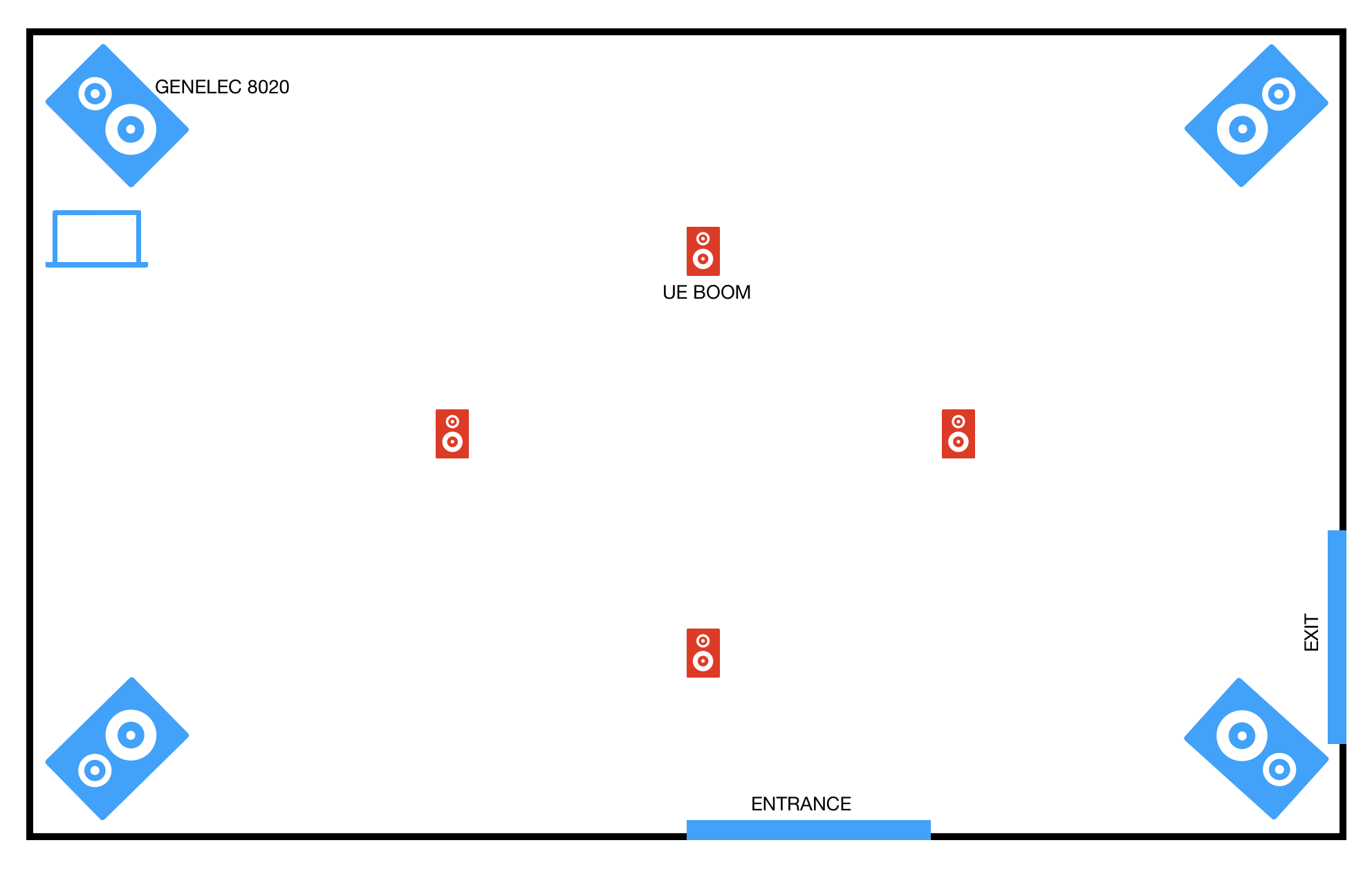
UMS ´n JIP, MusiMatrix 2020, audio setup
Die für MusiMatrix 2020
(eersteklasconcerten) entwickelte Performance integriert
zwei Werke: die Szene V (Merlin) aus UMS ´n JIP´s
electropop Oper Sancho (2019) und das dem Duo gewidmete
Werk Das Lachenmann IV von Motoharu Kawashima aus dem
Jahre 2017. Sie dauert etwa 20 Minuten und ist szenisch
einem Tagesablauf nachempfunden: Die Zuhörer betreten den
Raum bei Nacht, legen sich zum Schlafen hin und erwachen
bei Sonnenaufgang. Sie stehen auf, sobald die Sonne im
Zenit steht und ruhen bei Sonnenuntergang wieder. Der
Sonnenverlauf wird mittels Lichtregie inszeniert. Es
spielen UMS und JIP, unterstützt von zwei Musica-Lehrern
als Animatoren. Die Zuhörer befinden sich in einem
Doppelakusmonium. Vier Genelec 8020 sind in den vier Ecken
des Raumes aufgestellt, in der Mitte des Raumes befindet
sich ein weiteres Lautsprecherquadrat mit vier
omnidirektionalen UE Booms, damit ist eine gleichmässige
Klangverteilung im Raum gewährleistet. Alle acht
Lautsprecher befinden sich auf 1m Höhe (der approx.
Ohrenhöhe der Kinder). Die Kinder betreten den
verdunkelten Raum und bleiben in der Mitte desselben
stehen, äusserst leise sind Atemgeräusche und
Labium-Frullati aus den UE Booms zu hören: diese Klänge
und Geräusche mischen sich unmerklich mit live gespielten
Geräuschen zu einer zarten und zerbrechlichen
Klanglandschaft, welche aufmerksames Zuhören verlangt. Die
Kinder legen sich hin, alsobald startet die Szene V aus
Sancho, das äussere Akusmonium schaltet sich zu, der Raum
wird nun in seiner vollen Grösse bespielt. Die Parts von
UMS und JIP integrieren sich in das Zuspielband derart,
dass ihre Ortung nicht mehr eindeutig ist, ein Spiel mit
Realität und Fiktion beginnt. UMS spielt in der Mitte des
Raumes, JIP schreitet singend an den äusseren Rändern des
Raumes entlang. Die Szene V aus Sancho etabliert zunächst
Einzeltöne und Geräuschimpulse, welche mit Stimme und
Blockflöte erzeugt werden. Die Klanglandschaft erinnert
von Ferne an Geräusche im Gehölz. Die Knack- und
Zischlaute verdämmern allmählich, die Töne verdichten sich
zu Akkorden, zunächst zu Terzen, danach zu instabil
intonierten Dur- und Molldreiklängen, welche sukzessive
nach oben gleiten. Allmählich werden die Kinder
aufgefordert, diese Klänge zu imitieren und sich
individuell wie in Gruppen in die Klanglandschaft zu
integrieren (die
Klänge der Szene V lassen sich mit der Stimme und den
Händen (Schnalzen, Schnippen, Summen, Pfeifen) leicht
kopieren). Am dramaturgischen Höhepunkt dieser
Szene bricht bei Minute 12 ein Lachen ein, die Szene V aus
Sancho wird ausgeblendet. Verschiedene Lacher, welche
motivisch mit dem Stück Das Lachenmann IV verknüpft sind,
werden etabliert und von den Kindern spielerisch
nachgeahmt. Danach wird Das Lachenmann IV gespielt. Lachen
ist in unserem sozialen Umfeld mit Spontaneität
assoziiert. Lachen kompositorisch bzw. als musikalisches
Strukturelement zu verwenden führt den Zuhörer in eine
reizvolle Grauzone, weil es den Grenzbereich von Klang und
Bedeutung auslotet und mit grundlegenden Erwartungen
innerhalb unserer Kommunikations-Codices spielt, indem
emotionale Ausbrüche (in diesem Werk in Form eines
Lachens) formal und klanglich in eine Komposition
eingebunden werden. Das Kompositions- und
Performancematerial wird über die Aufführungen hinaus
unterrichtsgerecht aufbereitet. Die Schullehrer erhalten
Übungsblätter, um das Erlebte spielerisch nachzubereiten,
weiterzuentwickeln und nachklingen zu lassen.



UMS ´n JIP
score excerpts from Sancho, Scene V

Motoharu Kawashima
score excerpts from Das Lachenmann IV
![]()


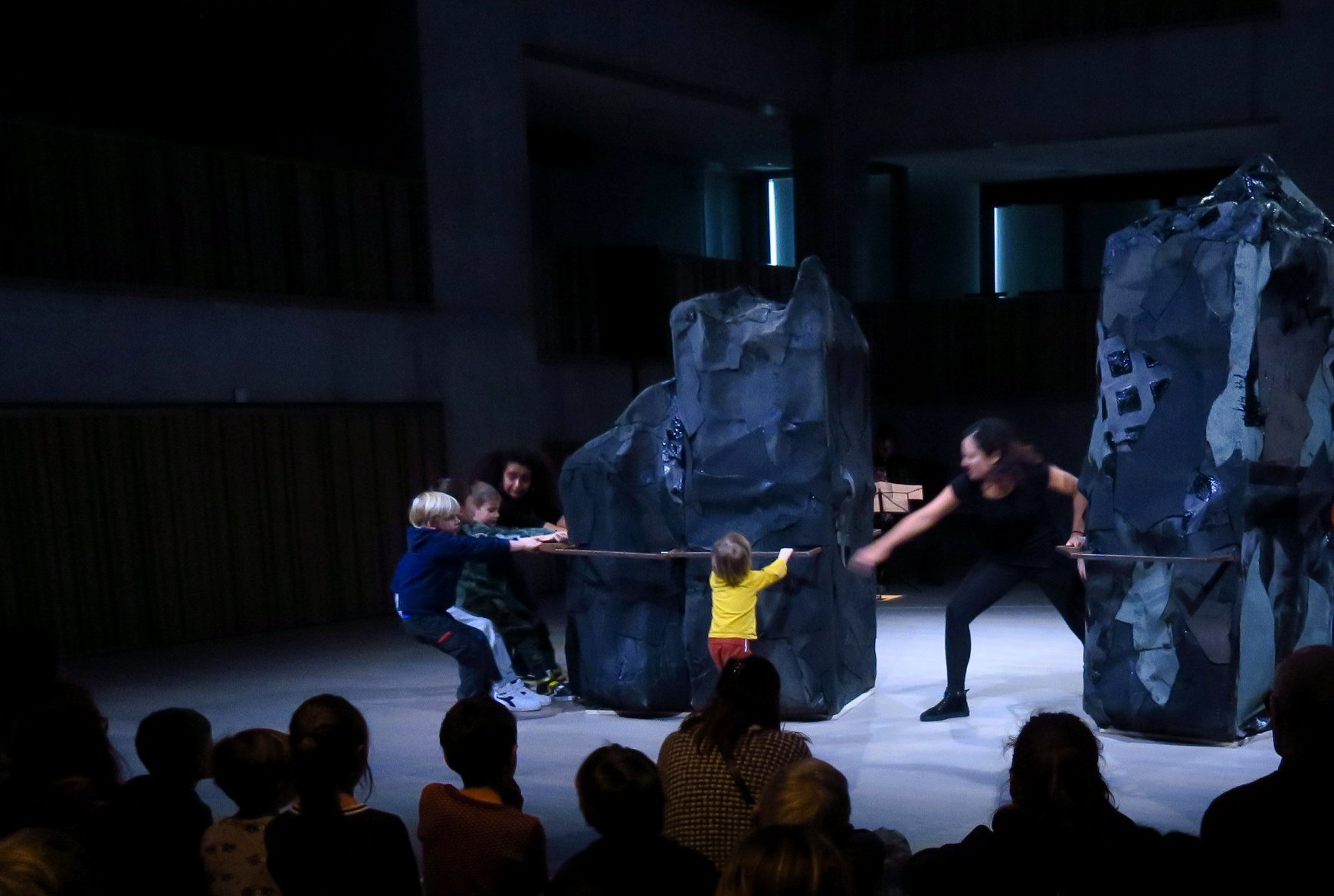












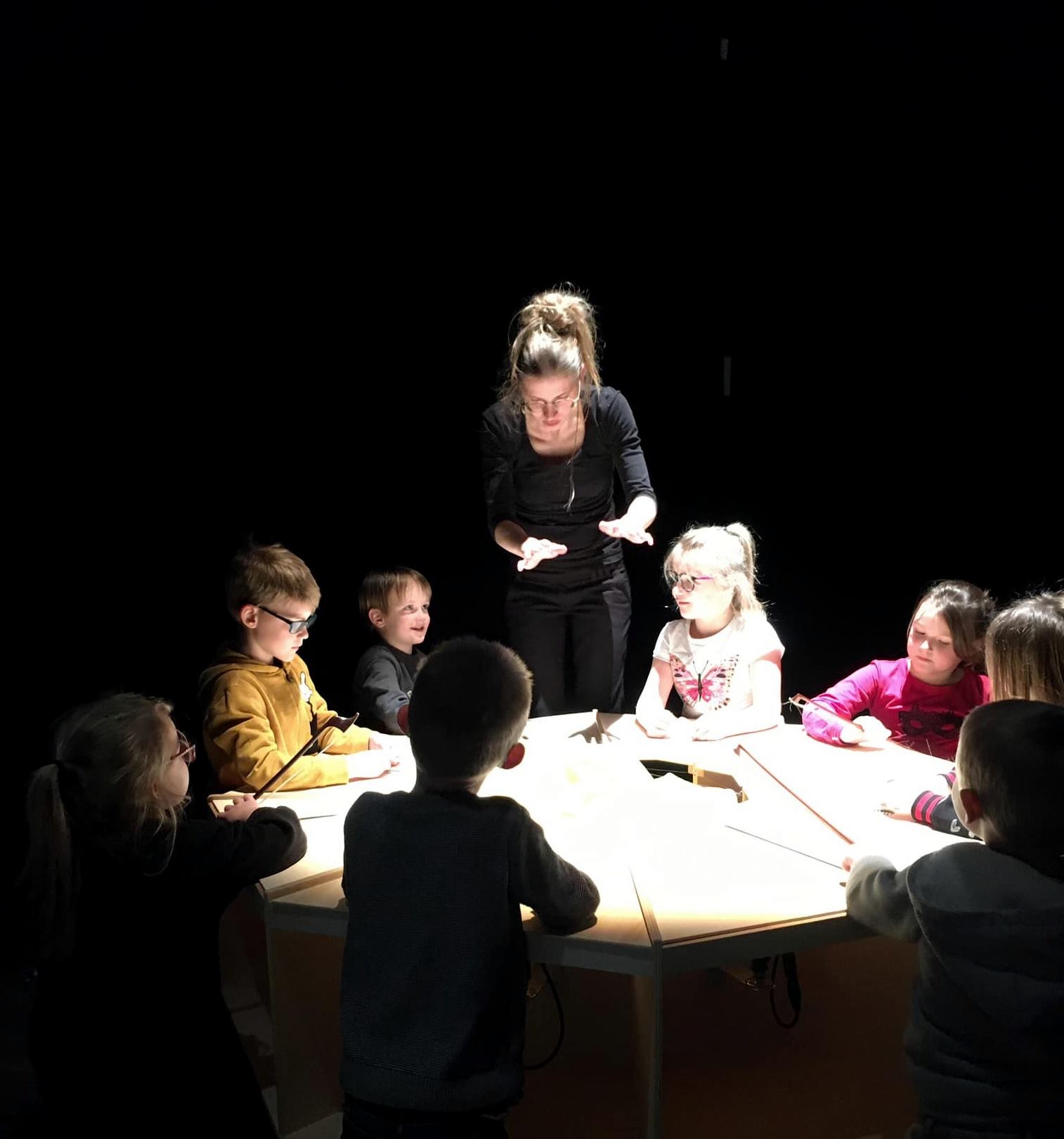


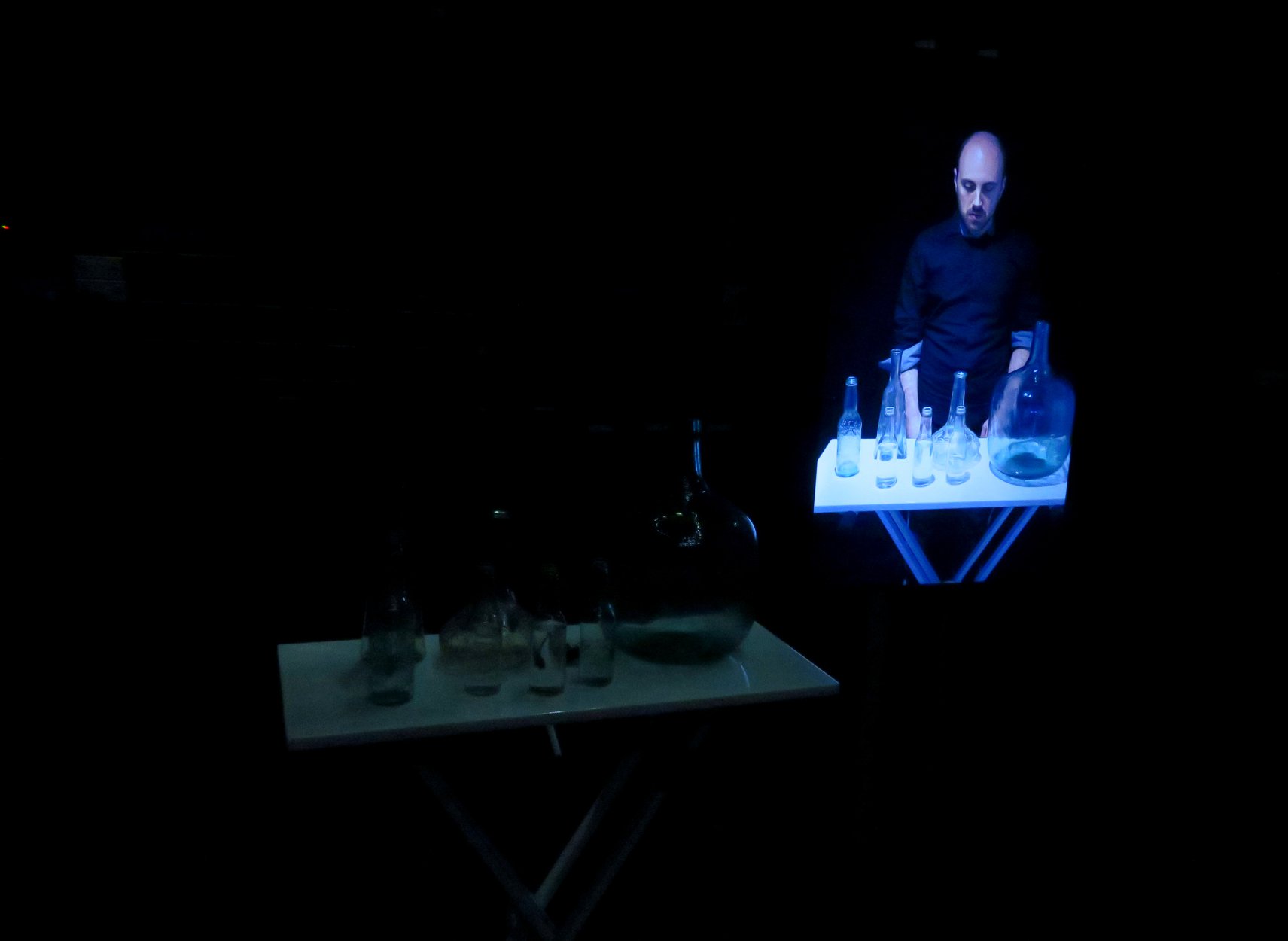















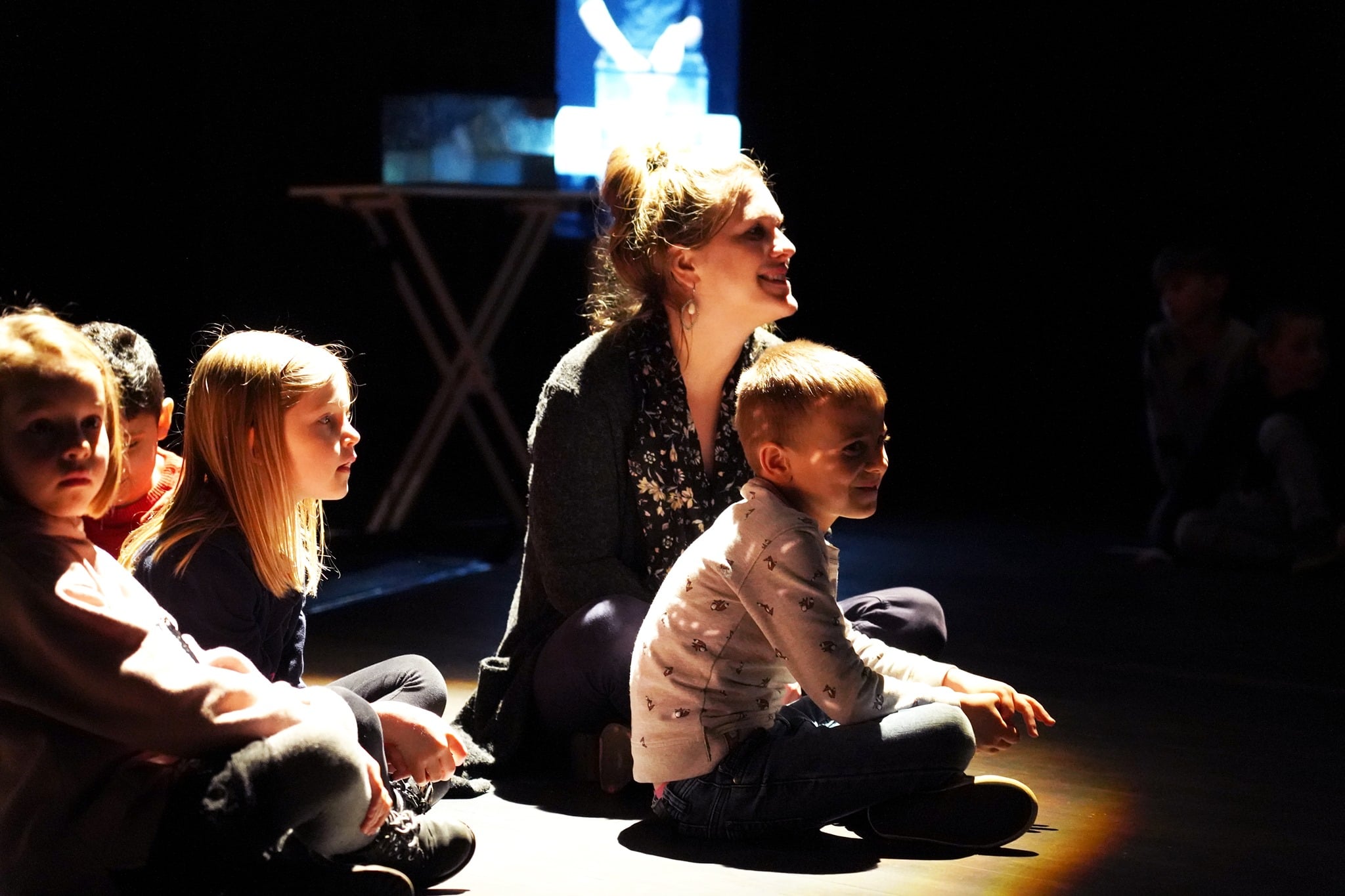





![]()
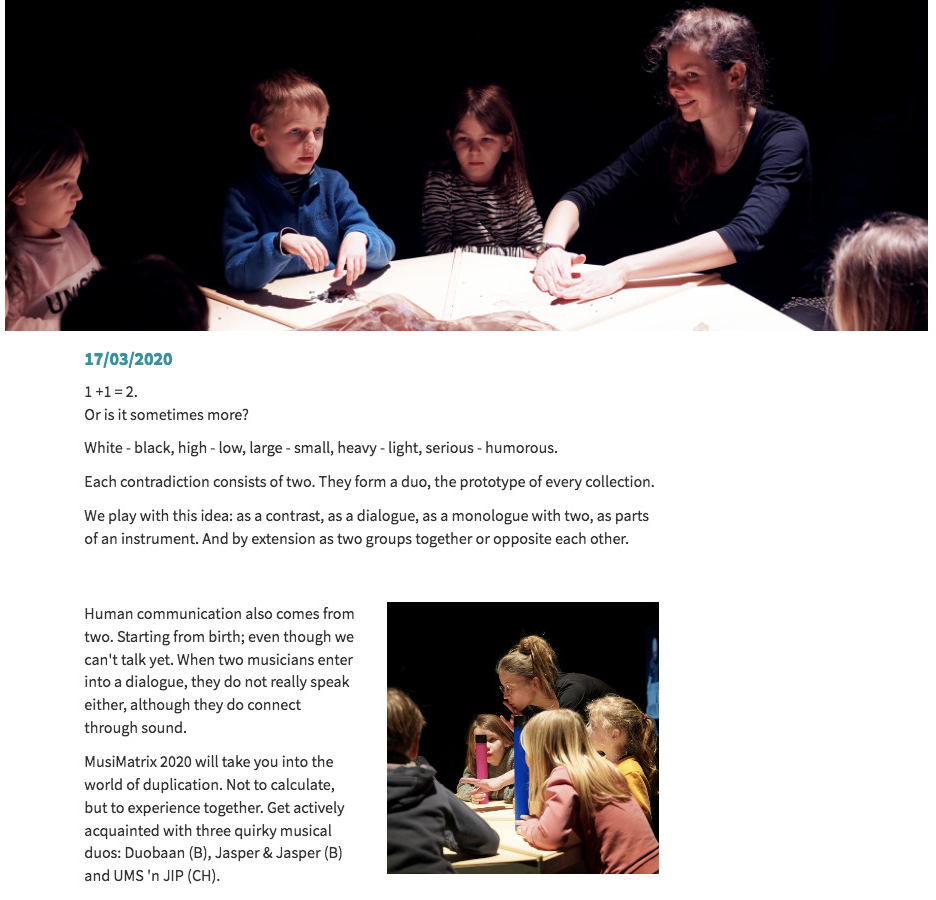

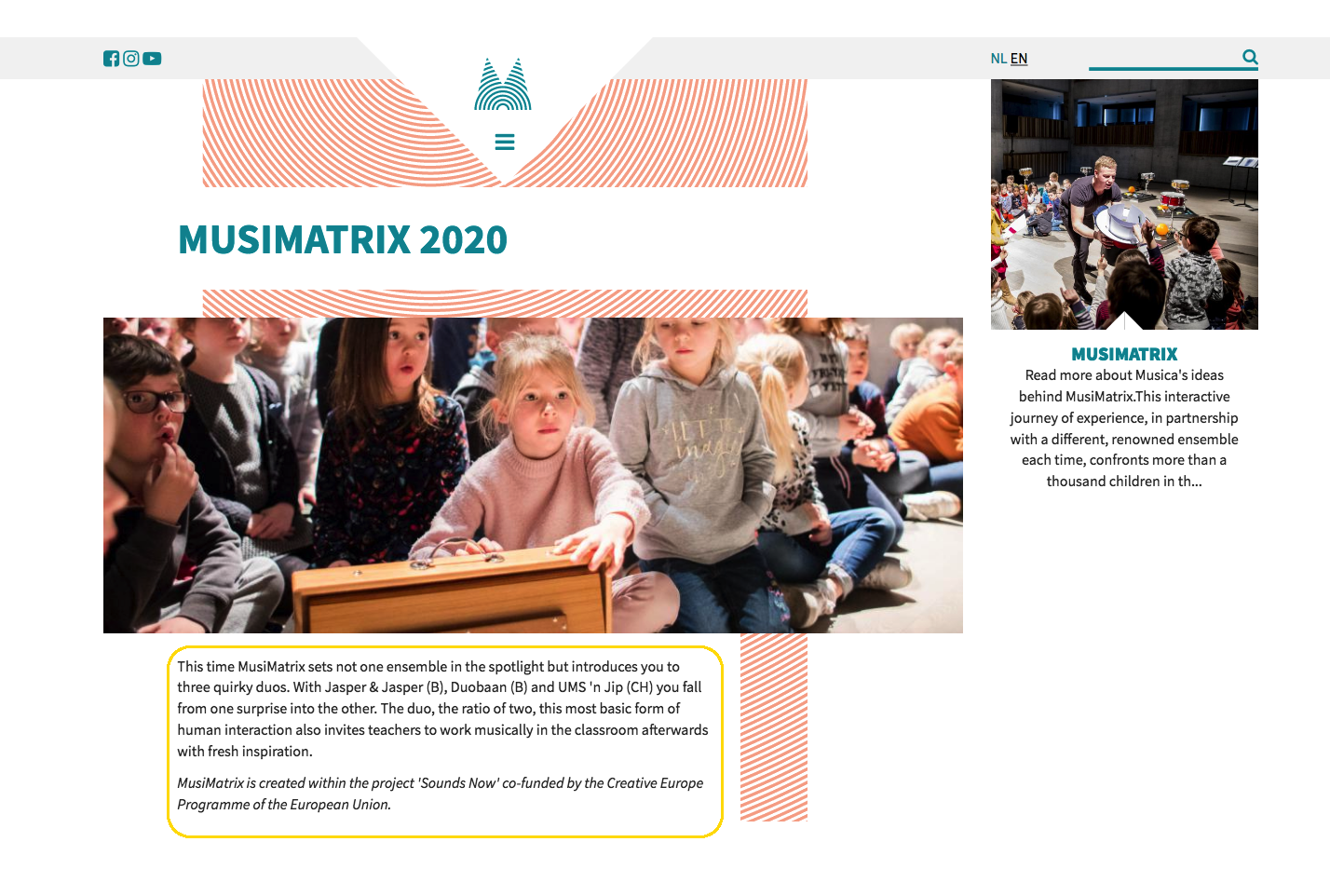

![]()















